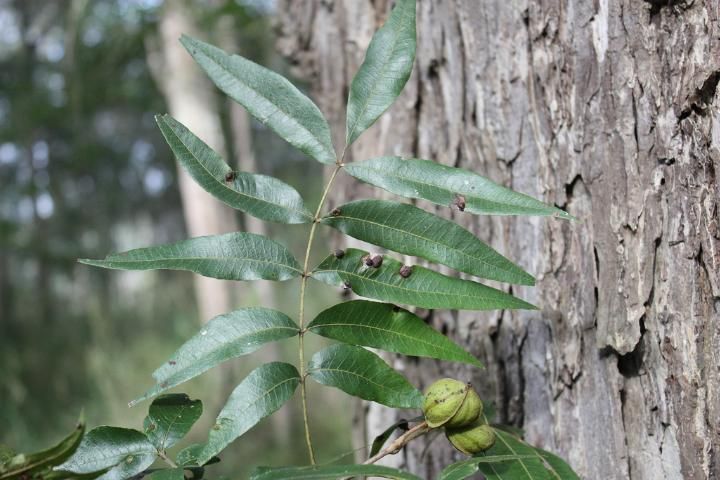Family
Juglandaceae, walnut or hickory family.
Genus
Carya stems from the Greek word caryum, meaning "nut" or "nucleus."
Species
The species name, aquatica, is the Latin term for "growing in or under water."
Common Name
Water Hickory, Swamp Hickory, Bitter Pecan
The two common names, water hickory and swamp hickory, both refer to the tree's habit of growing in the wet soils of stream banks and floodplains. Its other common name, bitter pecan, stems from the bitter taste of the tree's seeds.
Description
This deciduous Florida native is found in wet but well-drained soils along stream banks and flood plains throughout the southeastern United States. It ranges from the eastern Carolinas, south to central Florida, and west to eastern Texas. It grows best in full sunlight or partial shade, and can reach heights of 60 to 70 feet. The pinnately compound leaves are alternately arranged and can grow to between 9 and 15 inches long. Seven to 17 lance-shaped leaflets with finely serrate margins appear on each leaf and range in length from 3 to 10 inches. The topside of the leaflet is dark green and glossy, while the underside is a paler green with sparse pubescence (or hairs) present along the veins. Water hickory bark is gray or light brown with narrow cracks that give rise to reddish scales. When mature, the bark looks shaggy with flakey plates. Small greenish flowers bloom in the spring. Male and female flowers bloom on the same branch between April and May, with male flowers occurring in three-stemmed clusters called "catkins," while 2 to 10 female flowers appear on short stalks. The bitter nuts or pecans are enclosed in a dark brown, 1- to 1 ½-inch-long, thin-shelled husk, which splits along four winged seams to release the nut.

Credit: CA Floristics, CC BY-NC-SA 2.0
Allergen
Pollen in the hickory genus ranges between highly allergenic to extremely allergenic.
Applications
Commercial/Practical
Water hickory wood is not structurally stable and is therefore commonly used for fuel rather than lumber. Historically, members of the Carya genus have had various uses, including the production of dyes, baskets, bows and arrows, corn beaters, blow gun darts, and tool handles.
Medicinal
The Cherokee tribe used various members of the Carya genus to make medicines to address colds, excessive bile, small cuts and abrasions, and sore mouths.
Wildlife
Water hickory is a dominant species in floodplains and therefore plays an important role in purifying water that travels from the uplands into the bottomlands. Water hickory's presence in floodplains also contributes to wildlife habitat, and water hickory nuts are a food source for ducks, squirrels, and other wildlife.
References
Austin, D. F. 2004. Florida ethnobotany. Boca Raton, FL: CRC Press.
Borror, D. J. 1988. Dictionary of root words and combining forms (1st ed.). Mountain View, CA: Mayfield Publishing Company.
Burns, R. M., B. H. Honkala, and coordinators. 1990. Silvics of North America: Volume 2. hardwoods (Vol. 2). Washington, D.C.: U.S. Government Printing Office.
Florida Forest Stewardship. 2006. Trees of Florida: Juglandaceae. Retrieved from http://www.sfrc.ufl.edu/Extension/ffws/tfjug.htm#aquatica
Gledhill, D. 1989. The names of plants (2nd ed.). Cambridge: Press Syndicate of the University of Cambridge.
Godfrey, R. K. 1988. Trees, shrubs, and woody vines of Northern Florida and adjacent Georgia and Alabama. Athens, GA: The University of Georgia Press.
Haehle, R. J. and J. Brookwell. 2004. Native Florida plants: Low-maintenance landscaping and gardening. Lanham, MD: Taylor Trade Publishing.
Little, E. L. 2005. National Audubon Society field guide to trees, Eastern region. New York, NY: Alfred A. Knopf.
Ogren, T. L. 2000. Allergy-free gardening: The revolutionary guide to healthy landscaping. Berkeley, CA: Ten Speed Press.